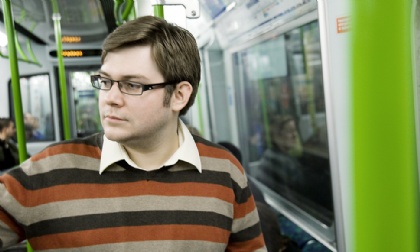 |
| Elusiveness - Steven Daverson by Markus Böggemann |
|
by Markus Böggemann
Steven Daverson’s music conjures up the beauty of the intangible: forms that remain in flux, that do not come together to form clearly delineated bodies; things one can see but not touch, – these phenomena are all the more fascinating for their counter-intuitiveness and reveal the salient aspects of Daverson’s rich compositional fantasy. The title of his cycle Elusive Tangibility, of which parts II, IV and V have been completed, alludes to this conception – and lives up to it musically: The fifth in this series of compositions, Zugunruhe for large ensemble (2008), establishes a number of fluctuating figures that constantly waver between transitory vagueness and motivic concretisation without forming enduring structures. The title uses an image of this compositional technique in a deliberate way: one imagines cloud formations or, analogous to the title of the work,[1] flocks of birds gathering. More important than such images (which, of course, always depend on the listener’s individual imagination) is the poetic idea they are based on – in the composer’s own words, the idea of a “dialogue between the weightless and the settled”. Such an equilibrium between the floating and the sedimentary contains an element of contrary motion that in different ways also characterises others works by Steven Daverson. In Face of Blades for solo violin (2009) the musical material is gradually peeled out of an opaque, noisy beginning; the course of the composition does not follow a model of organic growth, but rather the idea of a reduction and differentiation of the initial state. The forms, figures and sound events thus created are at the same time subjected to a temporal structure, forcing them into ever smaller units, compressing them, and finally destroying them. The lure of violence that becomes evident here appears at first glance to contradict the pursuit of balance; rigid structures like that of the temporal organisation in Face of Blades are not, however, an end in themselves for Steven Daverson, but rather a dramaturgical tool. On the one hand they set off musical processes of concentration and (self-) destruction, whose dramaturgical energy becomes immediately evident to the listener. On the other hand they are a starting point for compositional activity: precisely where their rigidity appears to be taken to an extreme, they open up the possibility of attenuating, compensatory, humanising intervention. Finally, beyond all strategic functions in the compositional process, this method generates exceptional sound textures that are, by virtue of their density, reminiscent of techniques and role models from the visual arts. It is not without reason that the composer describes his work in terms of sculpture. Once again, one arrives at the specifically haptic quality of his music, its special and yet elusive physicality. [1] The German word ‘Zugunruhe’ refers to anxious behaviour in migratory animals, especially in birds. It is sometimes translated as ‘migratory restlessness’; but many English academic texts leave it untranslated. |
 |
 |
|
| Photo: Manu Theobald © Ernst von Siemens Musikstiftung |
|
 |
|
Elusive Tangibility II: firelife (2008)
clarinet, violin, viola, violoncello
ensemble recherche
Elusive Tangibility III: Clandestine Haze (2011)
flute, clarient, viola, violoncello, trombone, percussion
ensemble recherche
Elusive Tangibility IV: Tsukimi (2008)
female voice and 10 instruments
Ensemble Modern
Elusive Tangibility V: Zugunruhe (2008)
16 instruments
Ensemble Modern Escher's Pharmacy (2011)
flute, oboe, clarinet, piano, violin, viola, violoncello
ensemble recherche
Schattenwanderer (2011)
clarinet and 7 instruments
Ensemble Modern, Nina Janßen-Deinzer (clarinet)
A co-operation of Ernst von Siemens Music Foundation and col legno
A co-production with Südwestrundfunk
A co-production with Hessischen Rundfunk |
1CD | Contemporary | Ernst von Siemens Musikstiftung |
|
 |
 |
| Recommendation |
|
|
|
|
“…as if the music had shed each of its shells and skins one after the other, to finally stand revealed in all its naked essence.”  |
 |
|
|
|
|
Hèctor Parra’s working on a composition is comparable to the work of a sculptor; continually he carves out his oeuvre out of the musical material. Listen to the result here!  |
 |
|
|
|
|
Remembrance and Polyphony. Ernst von Siemens composer’s award winner Ulrich Alexander Kreppein.  |
 |
|


